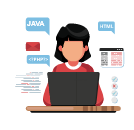Learn MS Access from the Best Tutors
Search in
Asked by Sajjan Last Modified

Sadika
While I can't provide you with an actual font here, I can certainly guide you on how to create a Microsoft Access database. Make sure to follow these steps:
Open Microsoft Access:
Choose a Blank Database:
Name Your Database:
Select a Location:
Create Tables:
Establish Relationships:
Create Forms:
Design Queries:
Build Reports:
Data Entry:
Remember, this is a basic guide, and the complexity of your database will depend on your specific needs. Always consider normalizing your data, using proper data types, and applying good database design practices.
Related Questions
Now ask question in any of the 1000+ Categories, and get Answers from Tutors and Trainers on UrbanPro.com
Ask a QuestionRecommended Articles
Make a Career as a BPO Professional
Business Process outsourcing (BPO) services can be considered as a kind of outsourcing which involves subletting of specific functions associated with any business to a third party service provider. BPO is usually administered as a cost-saving procedure for functions which an organization needs but does not rely upon to...
Read full article >
What is Applications Engineering all about?
Applications engineering is a hot trend in the current IT market. An applications engineer is responsible for designing and application of technology products relating to various aspects of computing. To accomplish this, he/she has to work collaboratively with the company’s manufacturing, marketing, sales, and customer...
Read full article >
Make a Career in Mobile Application Programming
Almost all of us, inside the pocket, bag or on the table have a mobile phone, out of which 90% of us have a smartphone. The technology is advancing rapidly. When it comes to mobile phones, people today want much more than just making phone calls and playing games on the go. People now want instant access to all their business...
Read full article >
Top 5 Skills Every Software Developer Must have
Software Development has been one of the most popular career trends since years. The reason behind this is the fact that software are being used almost everywhere today. In all of our lives, from the morning’s alarm clock to the coffee maker, car, mobile phone, computer, ATM and in almost everything we use in our daily...
Read full article >
Looking for MS Access Training?
Find best MS Access Training in your locality on UrbanPro.
Are you a Tutor or Training Institute?
Join UrbanPro Today to find students near youFind best tutors for MS Access Classes by posting a requirement.

Get started now, by booking a Free Demo Class